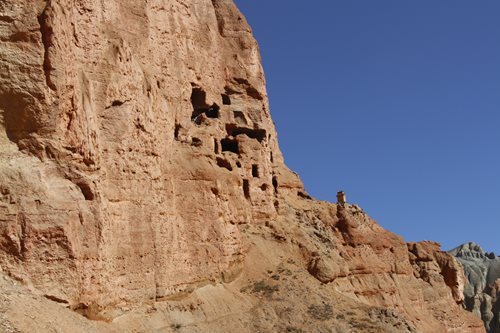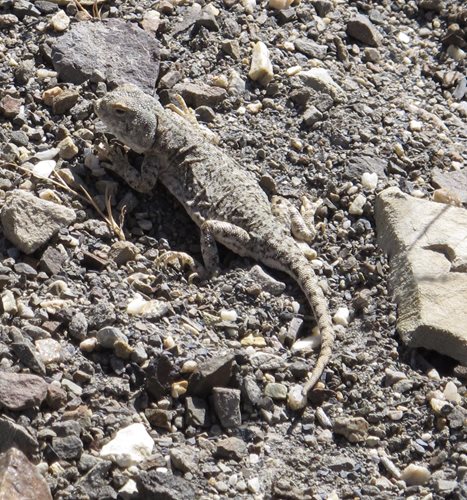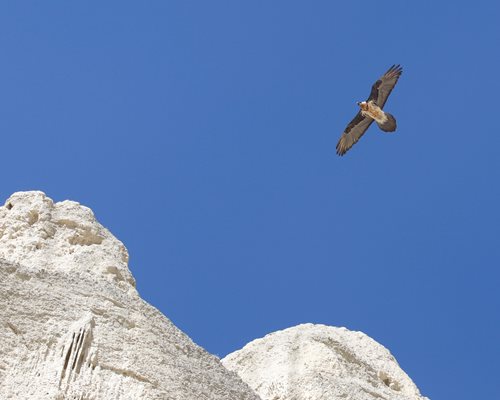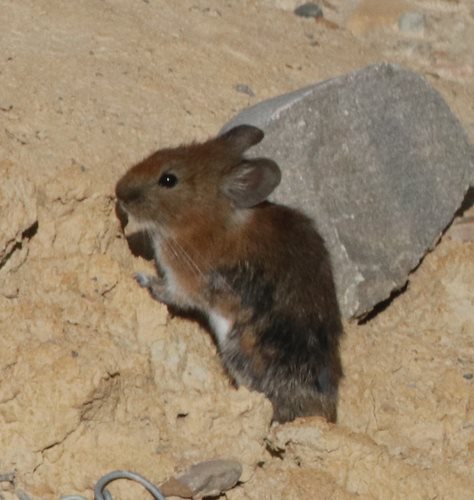The village of Ghami sits at a little over 3500m on the edge of the Tibetan plateau in Upper Mustang. Many, many years ago the village was plagued by a dragon which was eating all the children so the community sought the help of Guru Rimpoche.
The battle between the great man and the dragon was fierce and its blood stained the mountains red. Perhaps this reminder of the violence drove the monk to assuage his guilt and build the longest mani wall in Mustang, with each of the rocks within it bearing the mantra
om mani padme hum or an image of a bodhisattva. The landscape of Upper Mustang is Tolkienesque in places and there are innumerable sandstone towers that could so easily have been created by long-dead giants, or dragon-slayers. Indeed, I had no difficulty imagining some subterranean monster worming its way beneath our feet, bleeding still so that red seems to ooze between the strata. There are even baby dragons scampering around the parched scrubland.
 |
| Blood-red mountains where people have lived for millennia; these several-storey caves were carved out some 5000 years ago |
 |
| Fearless - what else could this be but a baby dragon? |
I’d set out on this ten-day trip into Upper Mustang a little pessimistic about seeing much wildlife as the land is so denuded and so very dry but early on our fourth day as we walked along the great mani wall and then further north, I noticed an odd solitary tree on the skyline high above us. When I looked again the tree was gone.
My binoculars revealed that the ‘tree’ was a distant Blue Sheep, so-called because their fur is battleship blue. The ram I’d first seen was on the lookout and as I scanned the sparse mountainside I made out more and more of his herd: it was great to see a rare species apparently thriving here.
One of the surprising things that surprised me about Mustang is the way the amount of plantlife varies so much. Often there is very little, then a turn in the path and we’d enter a new little valley with a little more water and everything was suddenly a lot greener. That fourth day a we’d planned would be easy so we could enjoy pausing to admire butterflies, kestrels, small birds and even the occasional flower. Then arriving in Drakmar (3820m) felt like we’d entered a Shangri La. People had irrigated gardens and orchards from the little river that runs through the community and it was obvious why people had lived here for at least 5000 years.
The fifth day had us ambling through the poplars, admiring redstarts and clouded yellows and then marching on north. The next climb wasn’t easy as I was noticing the altitude but how much happier I was to have escaped the ‘roads’ so I could appreciate the natural habitats. Again the landscape was dry and all the plants were stunted, armoured and many were scented as I brushed against them but then, much to our delight a beautiful pika – cute little relatives of hares but lacking the long ears – posed for us.
As we trudged upwards, Ram Kumar pointed out rounded Blue Sheep droppings and also the larger oval Tahr poo, an ever scarcer species, featured on the 50-rupee banknote. We even startled a few ‘baby dragons’ along the way. Wildlife was doing surprising well here. Not only was there life at ground level but Himalayan Griffon Vultures and also Lammergeyers swooped by to check us out.
On up, we summited the ridge at about 4200m and here found a green plateau and a collection of burrows seemingly excavated by a veritable village of pica. My assumption that a landscape only half covered in vegetation would be devoid of mammals was quite, quite wrong, clearly.
Then as this was Nepal, having climbed up, we needed to go down. As we descended into Ghar Gumba (3920m), movement drew our attention to the bounding grey form of a fluffy-tailed Himalayan Woolly Hare. Close by, a family of marmots, kept careful lookout for aerial predators.
 |
| We saw plenty of lammergeyers - photo by Simon Howarth |
The start of this trip is described in my previous blog
Beyond the Himalayan Watershed
Many of the animals we encountered also feature in my children's adventure stories
Himalayan Hideout and
Chasing the Tiger
The next blog (which is mainly photos) is
No-one is here
 |
| Royle's Pika or mouse hare thrives in harsh mountain conditions, despite the abundance of predators |
 |
| Nepali banknotes celebrate local wildlife and the older Rp 50/- note features the tahr |